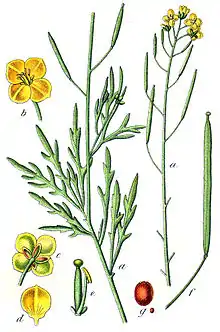Diplotaxis tenuifolia
Diplotaxis tenuifolia is a species of flowering plant in the mustard family known by the common names wild rocket and perennial wall-rocket. This plant is native to Europe and Western Asia. It can be found throughout much of the temperate world where it has naturalized.
| Diplotaxis tenuifolia | |
|---|---|
 | |
 | |
| Scientific classification | |
| Kingdom: | Plantae |
| Clade: | Tracheophytes |
| Clade: | Angiosperms |
| Clade: | Eudicots |
| Clade: | Rosids |
| Order: | Brassicales |
| Family: | Brassicaceae |
| Genus: | Diplotaxis |
| Species: | D. tenuifolia |
| Binomial name | |
| Diplotaxis tenuifolia | |
| Synonyms | |
|
Sisymbrium tenuifolium | |
This is an erect mustard-like plant with branching stems that may exceed half a meter in height. It grows in clumps on the ground in a variety of habitats and is a common weed of roadsides and disturbed areas. It has long leaves which may be lobed or not. The foliage is aromatic when crushed. Atop the branches of the stem are bright yellow flowers with four rounded petals each about a centimeter long. The fruit is a straight, flat silique up to five centimeters long.
Common names
Perennial wall rocket,[1] wild rocket, sand rocket, Lincoln weed, white rocket; seeds sometimes marketed as "wild Italian arugula" or "sylvetta arugula".
Nutrients
Wild rocket is high in ascorbic acid, carotenoids, polyphenols and glucosinolates (above all glucosativin and glucoerucin, which are the cause of the pungent flavour).[2] When the leaves are chewed glucosinolates, through the enzyme myrosinase, are metabolized in isothyocyanates[3] and indoles.[2]
Commercial cultivation
Baby leaf rocket is cultivated worldwide as a salad leaf. In addition to D. tenuifolia, the annual Eruca sativa is grown and marketed under the same common names. These leaves are usually mixed with other baby leaf crops to form a mesclun-style salad. These crops have become popular due to their distinctive taste and texture in salads.
Leaves preserved at 5 °C show a loss of ascorbic acid and glucosinolates and an increase in polyphenols (then preservation after harvesting may be nutritionally good, since for example sinapic acid and ferulic acid have anti-cancer effects and umbelliferone is an anti-oxidant).[3]
Uses
One of Trotula's works, Treatments for Women mentions "wild rocket cooked in wine" in a remedy for sanious flux in women.[4]
References
- "BSBI List 2007". Botanical Society of Britain and Ireland. Archived from the original (xls) on 2015-01-25. Retrieved 2014-10-17.
- Bell L, Oruna-Concha MJ, Wagstaff C (1 April 2015). "Identification and quantification of glucosinolate and flavonol compounds in rocket salad (Eruca sativa, Eruca vesicaria and Diplotaxis tenuifolia) by LC-MS: highlighting the potential for improving nutritional value of rocket crops". Food Chem. 172: 852–861. doi:10.1016/j.foodchem.2014.09.116. PMC 4245720. PMID 25442630.
- Spadafora ND, Amaro AL, Pereira MJ, Müller CT, Pintado M, Rogers HJ (15 November 2016). "Multi-trait analysis of post-harvest storage in rocket salad (Diplotaxis tenuifolia) links sensorial, volatile and nutritional data" (PDF). Food Chem. 211: 114–123. doi:10.1016/j.foodchem.2016.04.107. PMID 27283614.
- Green, Monica H. (2002). The Trotula : an English translation of the medieval compendium of women's medicine. Philadelphia: University of Pennsylvania Press. p. 97. ISBN 978-0812218084.
External links
| Wikimedia Commons has media related to Diplotaxis tenuifolia. |
- Jepson Manual Treatment
- USDA Plants Profile
- D. tenuifolia photo gallery – CalPhoto (University of California website)
- "Some Perspectives on Rocket as a Vegetable Crop: A Review" – 2012 article in Vegetable Crops Research Bulletin on ResearchGate.net